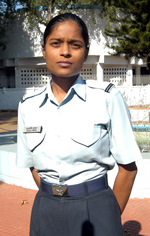Inspired by Laura's post at The Valve----------------------
Amrik Badnaam Goes To the Library
Professor Amrik Badnaam liked to spend his days during the long semester breaks in the libraries of other universities. His own university's library was somewhat distant from home, and was at any rate a rather dismal space: something undefinable was
off about the library, which made it an unpleasant place to work. Many of his students felt the same way, and tended to avoid the place.
Since Amrik and his wife had recently moved to a new town within driving distance of the university, there was now a need to find a new library to haunt while he continued to work on his schlarly project, on the function of quoted dialogue in early novels. Amrik didn't need much in the way of resources from the library itself; for several years he had had in his own personal collection all the texts he required. But owing to certain changes he had made in the methodology of the project Amriknow found himself mired in an exhausting re-reading of most of his primary materials. Amrik's primary task this winter would be to skim through about 30 volumes by a prolific French writer named Marcel Broodthaers (a Victorian ancestor of the well-known contemporary artist of the same name), scanning for irregularities in the use of quotation-marks.
In truth, it was boring work, and the professor often wandered the stacks of the local library for interesting books to sample during breaks. Sometimes it might be a volume on the
Peloponnesian Wars; on other days it might be a radically hostile biography of Mohandas Gandhi. In the past two years of work at various university libraries, such random sampling had come to occupy more and more of Amrik's time.
The new library he had selected was the main library at Blue Bough County Community College (also known as "BB3C"). Though he quickly ascertained that the library's primary selection was limited (
Pamela, but no
Shamela), he noted with satisfaction the congenial design of the library after a quick walk-through: this was a space in which he could actually get some work done. It was generally bright and spacious, and had a pleasing contemporary roundedness to it. Clearly a great deal of money and thought had gone into the construction of the building, much more than one might expect from a community college.
On the first day of work during what would turn out to be his last winter break as a faculty member at Prussian State University in eastern Pennsylvania, Amrik sat down at a suitable carrel near the Pxxxx section of the stacks at BB3C, opened his materials, and began to work. But he was only able to focus on Broodthaers for about half an hour before he found his mind wandering a bit. Amrik decided to browse the BB3C literature stacks a little, just to see what was there.
The Collected Works of Randall Jarrell caught Amrik's eye, and he thumbed through to find his favorite poem from his undergraduate days, "The Snow-Leopard." But the poem did not seem as exciting to him now as it had in college; indeed, it seemed curiously limp and certainly devoid of magic, as did many of the other bits and pieces of Jarrell poems he glanced at while standing in the book stacks. Next, Amrik picked up a volume of Amy Lowell,
Pictures of the Floating World, of which the BB3C library copy was, surprisingly, a first edition from 1919 (how could this little community college even have existed in 1919?). Though the volume was handsome, the poems, Amrik quickly realized, were quite odd.
Amrik glanced back at his carrel but felt he needed to do a little more browsing before sitting down again to work.
That was when it happened: while browsing the literature shelves, he saw a small volume with an impossible title,
Amrik Badnaam Goes To The Library. It was a slender volume with white binding and gold-embossed lettering on the spine. Upon opening the book, Amrik was shocked to find the following title page, written (rather than printed) in ink calligraphy:
Amrik Badnaam Goes To The Library
By Kalla Jadoorani
Wassahickon, PA: Blue Bough County Community College Press
December, 2005
The text that followed was, like the title page, written in ink rather than printed. The paper was a heavy bond, not often used in printed books, and seemed to be cut somewhat irregularly. The handwriting was a smooth and regular cursive script, quite legible but obviously made by an actual human being.
That the story narrated in
Amrik Badnaam Goes To the Library appeared to be identical to his own life story was somewhat frightening to Amrik, but also in a certain way thrilling.
Who is Kalla Jadoorani, and why has she hand-written an entire book (even a slim volume) consisting of my life story? After reading the first few pages in astonishment, Amrik quickly flipped to the back of the book to see where this Kalla Jadoorani had decided to end the story. Nearly the entire second half of the book was blank; the last written paragraph was on page 53, and read as follows:
That the story narrated in Amrik Badnaam Goes To the Library was his story was somewhat frightening to Amrik, but also in a certain way thrilling. Who is Kalla Jadoorani, and why has she hand-written an entire book (even a slim volume) consisting of my life story? After reading a letter-perfect account of his birth in Queens and his first years of life (including the blizzard of '77 and his early surgery), Amrik quickly flipped to the back of the book to see where this Kalla Jadoorani had ended things. He noticed that nearly the entire second half of the book was blank; the last written paragraph was on page 53 . . .
Amrik stood there, astounded and just a little bit annoyed that the book had ended at exactly the present moment. If this were some kind of trick, it wasn't especially original!
That was when he noticed a small Indian woman dressed entirely in black staring at him. She was standing at the far end of the stacks, and the only very noticeable thing about her were her thickly-rimmed, oddly shaped spectacles, which were either extremely out of fashion or extremely fashionable -- depending on how current one happens to be in the latest phase of retro fashion recycling. She seemed to be about forty, though that was in fact somewhat hard to establish in the middling light of this particular location in the stacks.
"Yes?" he finally said. She didn't say anything, or move. Indeed, she continued to stare at him with the same intense look.
"Wait, are you---?"
"Yes," she said, quickly. Then: "Listen, I haven't got a lot of time. Go back to your carrel and read the book, now, from beginnning to end exactly in sequence, and without skipping, skimming, or pausing for any reason. If you do it right, and the book works, you'll come back here and put it back on the shelf where you found it. Also, don't worry about the ending. I haven't finished writing it yet, obviously. I'll take it home and finish it tonight; it's important that I write the ending for everything to work. As for everything else, I'll explain what you need to know tomorrow." And before he could say anything, she was gone.
To be continued



 Don't even think about claiming sexual harassment if you're a woman in the Indian Air Force. First, your charges will be dismissed. Then, you'll be put in jail, "for your own protection." And finally, you'll be court-martialled on trivial charges, and convicted by a jury that, to add insult to injury, includes two senior women officers (one of whom is Air Marshal Padmavati Bandyopadhyay, the highest-ranking female officer in the Indian military).
Don't even think about claiming sexual harassment if you're a woman in the Indian Air Force. First, your charges will be dismissed. Then, you'll be put in jail, "for your own protection." And finally, you'll be court-martialled on trivial charges, and convicted by a jury that, to add insult to injury, includes two senior women officers (one of whom is Air Marshal Padmavati Bandyopadhyay, the highest-ranking female officer in the Indian military).